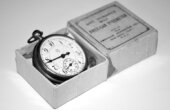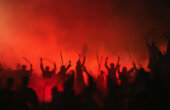The Dawn of the Colorful Kitchen
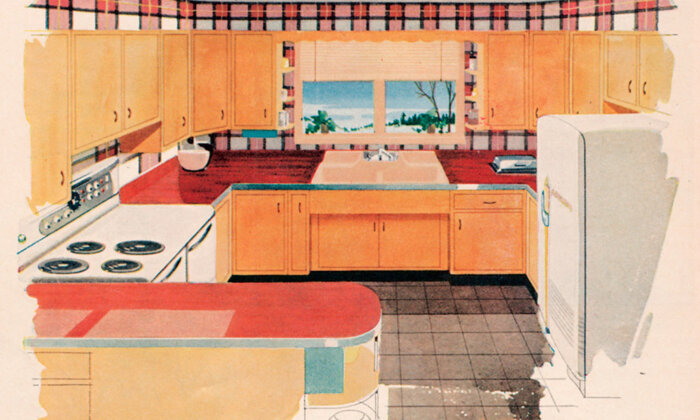
The bright postwar landscape, with its color-conditioned schools, its two-tone Chevys, and its orange-roofed Howard Johnson’s restaurants, whetted the appetite for more color in the home. Howard Ketcham’s work on the Bell Model 500, a direct response to this taste, was paralleled by the appliance industry’s move toward color. In the 1920s, Macy’s Color in the Kitchen promotion had popularized pots and pans in bright hues, and Kohler Color Ware had made some headway in the bathroom. But the colorization of big-ticket durable goods for the home had been stymied by the Depression and by World War II. In 1949, the Chambers Company, a small Indiana stove factory, startled everyone by offering stoves in red, black, blue, gray, yellow, and green. Rumors circulated that the colorful models accounted for one-third of the Chambers Company’s sales. When a major trade association for the paint industry reported the rising popularity of kitchens in canary yellow and chartreuse, the household equipment industry took notice.
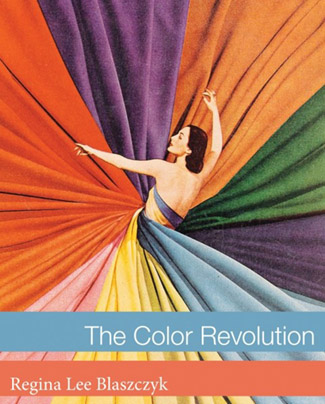
“Let’s face it,” said a 1951 report on women and electrical appliances compiled for the Ralph H. Jones Advertising Agency by Ernest Dichter’s Institute for Motivational Research. “The General Electric refrigerators, Kelvinator, and Frigidaire are not . . . different from one another,” making it hard to “capture the consumer’s heart by assaulting it . . . with a barrage of publicity.” The postwar appliance customer had most likely worked in an office, a store, or a factory during the war, and knew her own mind. Unlike her “old-homebody” mother, she decorated to express “her creativity and individuality.” She wanted “electrical appliances not only for their utilitarian value but for their contribution to her kitchen’s livability,” and she expected “the style of the refrigerator or washing machine ‘to harmonize with the rest of the kitchen’s décor.’” The manufacturers’ challenge was to turn a utilitarian product into a fashion accessory. Dichter, who had probed the minds of consumers for hundreds of companies, recommended a “psychological strategy.” Color, he suggested, was a psychological tool that could reach deep into the mind and unlock the consumer’s nascent or unrealized desires.
Unlike her “old-homebody” mother, the postwar appliance customer decorated to express “her creativity and individuality,” stated a 1951 report on women and electrical appliances by Ernest Dichter’s Institute for Motivational Research. She wanted “electrical appliances not only for their utilitarian value but for their contribution to her kitchen’s livability.”
The largest market for color appliances was to be found in new suburban developments such as the three Levittowns (one on Long Island, one in Pennsylvania, and one in New Jersey). Developers knew that the frazzled house hunter, exhausted after an endless Sunday afternoon of open houses, would remember “the one with the red and white kitchen.” But the populations of these new communities were less stable than the builders would have liked, and the rapid turnover affected how houses were designed. “Today,” according to a report from a conference on color in interior decoration sponsored by the builders’ magazine House & Home in 1955, “most people buy their homes ready made, just as they buy their clothes ready made or their cars ready made. Today only one house out of six is built for a known buyer, and even that one house in six will probably be re-sold to an unknown buyer within five years.” Color selection, always a risky business, was complicated by the anticipation of mobility.
Bankers and appraisers had to deem a house suitable to be resold before they would lend money to the builder or the homeowner. The “streamlined” kitchen — one with modernistic cabinets, chrome-trimmed counters, and color appliances — was still too unusual for cautious money men. “The builder can take his profit and run once he has found a buyer who likes the colors he has chosen, but the mortgage lender must live with the house for 20 or 30 years through many changes of ownership. He has the biggest stake in the use of safe colors, for he has the most to lose by a color choice that might lower the re-sale marketability of the house.” The Federal Housing Authority, which oversaw mortgage lending to veterans under the GI Bill of Rights, took a conservative stance. The editor of House & Home explained the realities to an appliance executive: “FHA now tends to give a lower valuation where color is used. This is for two reasons: 1. FHA is afraid color may reduce marketability, because the color that suits one woman may not suit the rest. 2. FHA has no accepted color standards that its appraisers can use as a yardstick.” The Housing Act of 1954 provided federal loans for remodeling and encouraged lenders to approve streamlined kitchens if remodelers wanted them. But a builder of new homes still couldn’t “use colors his mortgage lender will not finance.” In the end, the worries of bureaucrats, bankers, and appraisers limited the dissemination of colored appliances.
As consumers in urban neighborhoods and in older suburbs looked to modernize older homes, manufacturers of electric appliances saw sales opportunities. “One big reason the appliance makers are eager to sell color into the kitchen is their hope that colored kitchens in new houses will also start a big replacement demand as old houses follow the new house lead. That’s why General Electric is so pleased that 80% of its new house major appliance sales are in color.” GE hoped that the Piotrowskis, the Celluccis, the Goldblums, and the O’Neills would want to keep up with the Joneses, but identifying a market segment was not the same as realizing sales. How should manufacturers approach the replacement market? Should they target the consumer’s unrealized desires, or should they cater to her actual needs?
Most appliance executives took a pragmatic approach to these decades-old marketing questions, which had been codified in the 1920s. One salesman who supplied vitreous enamels to appliance makers knew Ernest Dichter’s psychological theories and was skeptical. Granting that the “consensus of the motivational research boys is that colors and built-in appliances are the only things that meet the emotional needs of the modern woman,” he expressed belief that the American manufacturing system could satisfy customers without bowing to fashion. Through “economics and mass production,” appliance makers could deliver affordable prices and a modicum of style. The purchasing agent for Levitt & Sons also skirted around the popular psychobabble and the idea of style obsolescence: “The idea of the colored kitchen is to attract the consumer to spending more money for her kitchen — money that would otherwise be spent for a television set or automobile — something new. It is eye-catching, appealing and she wants it.”
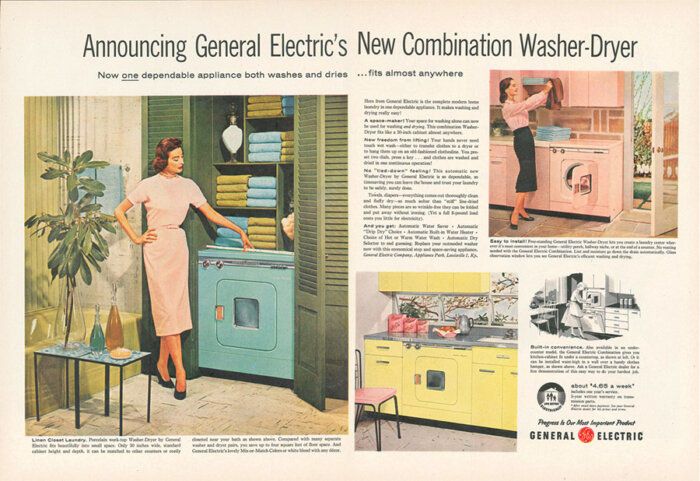
Market researchers at McCall’s, a popular magazine for middle-class suburban housewives, documented the rising interest in colorful appliances. By early 1955, the average homemaker had seen color appliances in magazines, stores, and showrooms, at open houses in new suburban developments, and in the homes of friends and relatives. Some women still preferred white appliances: “I love a change in decorating, especially in the kitchen where I spend so much time. I would hesitate to buy colored appliances for this reason. I pick neutral colors for counter tops and floors also, so I can change to any new color.” But more than half of the women in the McCall’s survey said they would buy a new appliance in color, even if it were more expensive. “I love color! I spend most of my time when home in my kitchen and like a pretty yellow kitchen. My appliances are white and no matter how I plan my color scheme, my range, refrigerator, [and] broiler stick out like ‘sore thumbs.’ If they were in pastel colors, they would blend.”
The trend toward thinking of the kitchen as a living space encouraged the new outlook. As more blue-collar families moved to suburbs, they took the idea of the all-purpose kitchen with them. In urban apartments, the large kitchen had served as a community gathering space, much as in a farmhouse. This vernacular tradition of adaptive use fit with Frank Lloyd Wright’s modernist concept of the open floor plan, with the kitchen opening into a dining-living room. Suburban builders adjusted their designs for Cape Cod cottages and split-level ranches to accommodate “nostalgic feelings for the days when the kitchen was the family living room” and “people ate near the stove and shared stories.” If the kitchen was a space for living, then it should be decorated as such, complete with colorful accents. Do-it-yourself paints allowed consumers to satisfy this impulse on a budget.
“The idea of the colored kitchen is to attract the consumer to spending more money for her kitchen — money that would otherwise be spent for a television set or automobile — something new. It is eye-catching, appealing and she wants it.”
Sunshine Yellow appliances required a more substantial investment and signified a greater commitment. As public opinion was gravitating toward color in kitchen decoration, a different obstacle to color appliances appeared: three out of four appliance dealers took “a dim view of the whole idea.” The retailers worried about higher prices, the difficulty of matching shades, and inventory management — many of the same worries that car dealers had about two-tone paint jobs. “The biggest headache will be having not only the right model but the right model in the right color and . . . the right shade. What about matching chipped stove panels? What prices will we have to pay for parts due to excessive inventory . . . in our distributors’ warehouses?” Stores that stocked different brands were especially concerned about mismatches: “There’s Sky Blue, Baby Blue, French Blue, Cadet Blue. . . .” The “color idea” was a big headache — lots of work and no guarantees.
A God-Sent Opportunity
At Frigidaire, it’s pastel. . . .Westinghouse terms it frosting. But top men agree: “A little color brightens a whole line’s sales.”
—Sales Management, 1956
In 1954, Frigidaire (the Dayton-based appliance division of General Motors) became the first manufacturer of kitchen equipment to offer a “full line” of color appliances. This meant that, like GM cars, Frigidaire color appliances came in several price brackets — Standard, Master, De Luxe, and Imperial — and were designed in Detroit by Harley Earl’s styling section. At Frigidaire, color did fit into a broader plan for style obsolescence — but not in the way Vance Packard described. In advising dealers to exploit color, Frigidaire headquarters explained how colored appliances fit into GM’s “ladder of consumption” strategy. The goal was not, as Packard wrote, to treat appliances like millinery, convincing “Americans they should replace refrigerators, ranges, and washing machines every year or so.” It was to encourage consumers to replace their older white appliances with the new colorized models bit by bit over the years, until the ensemble was complete.
Frigidaire’s well-developed national distribution network encouraged franchisees to push color. One dealer put the burden on the store managers — “the first essential to selling Frigidaire appliances in color is to have the guts to buy . . . color” — but regional tastes played a role. Consumers in warmer climates and in more recently developed regions of the country (the Southwest, the Rocky Mountains, the Pacific Coast) liked color; those in the industrial Northeast, the Midwest, and the Southeast did not.
The “crusade for color” gave store owners the chance to apply their “selling ability,” chatting up style and beauty to an “army of do-it-yourselfers who’ve been redecorating and have just got to the kitchen.”
Down-market stores shied away from color appliances, which had higher sticker prices than white ones. But in a middle-class or upper-middle-class market that could bear higher prices, a Frigidaire dealer could pocket 20 percent more from a color order. The co-owner of an appliance store in Salinas, California spotted a “God-sent opportunity” that would allow his store to compete with a neighboring Montgomery Ward store. “We felt that our big competitors couldn’t get into colored appliances quickly enough because their buying procedures and merchandising techniques are not as flexible as the smaller dealer,” Paul Kane told a trade journal. “We decided to get so well established as ‘color headquarters’ that it would be difficult for these stores to overtake us.” The “crusade for color” gave the partners the chance to apply their “selling ability,” chatting up style and beauty to an “army of do-it-yourselfers who’ve been redecorating and have just got to the kitchen.” They also sold customers on the idea that tinted appliances would have higher value at trade-in time.
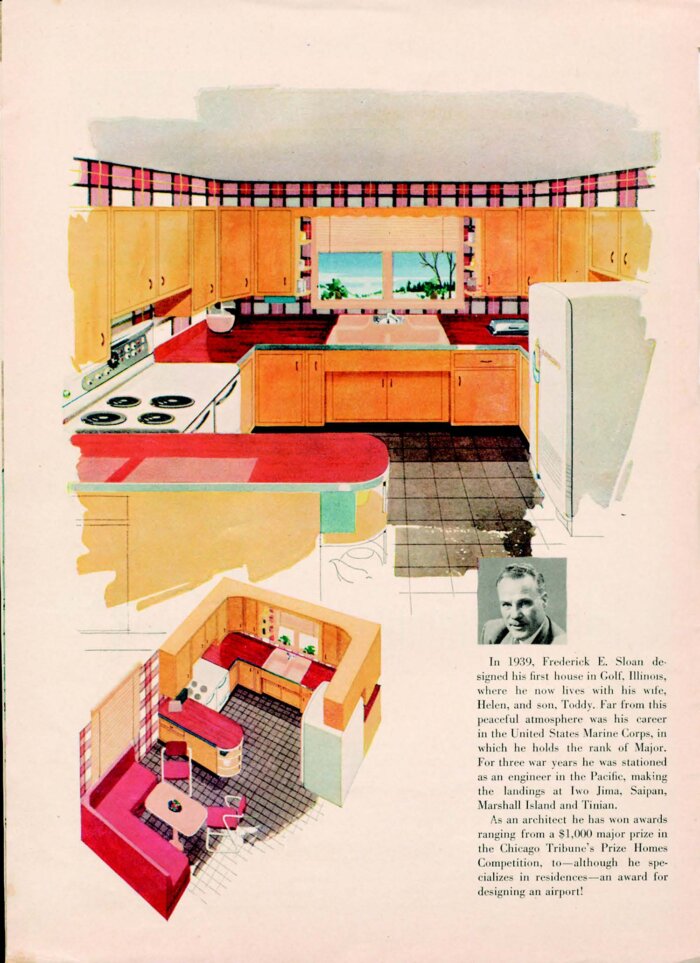
of America’s Smart Set.
In Texas, the Good Housekeeping Shop in Odessa had success with Frigidaire colors. The Good Housekeeping Shop, opened in the autumn of 1957, was the brainchild of an entrepreneurial appliance salesman familiar with the Houston and Odessa markets. Refusing to stock any brand of appliances other than Frigidaire, the Odessa store and a Midland branch “sold color aggressively.” Operating on the principle that “you can sell white over color but you can’t sell color over white,” the owner kept “complete displays of all colors in both stores.” Ensembles of matching appliances — a refrigerator, a range, a washer, and a dryer — were displayed in color groups, creating a rainbow effect that attracted customers into the showroom and held their attention. Salesmen were trained to “sell kitchen beauty and kitchen decoration as well as to sell the product.” One explained: “It is our habit to sell the item first, and then ask the customer which color will fit their color scheme the best, ‘What color do you want to buy?’” Three out of four shoppers who bought color returned within six months to purchase another major appliance. In 1958, nearly half of the shop’s orders were for color appliances.
Despite these successes, appliance dealers still saw white as “a safe bet” and worried about their ability to stock matching appliances down the road. In 1959, the Home Appliance Company in Texarkana, Texas, complained about the lack of colorized stock available in the Standard and De Luxe price ranges. In 1955 and 1956, the store had displayed color models and consumers had responded positively, particularly to mid-price ($300–$400) refrigerators. Forty-nine percent of the refrigerators and 37 percent of the ranges sold that year were colorized. But since then, the dealer had had trouble getting colorized models in low and middle price ranges from the distributor, much to the chagrin of customers. “In the appliance business, we do not sell a complete kitchen every time.” When a customer who had bought a Standard refrigerator returned for a matching stove, she found that her only option, if she wanted to match the color, was a top-of-the-line Imperial priced at nearly $450. As a result, sales of colored appliances had fallen by nearly 10 percent. “I don’t think it is right to start a customer with color . . . when she could not complete the color due to the high price.”
“The stylists’ fascination with pastels exhausted itself before the 1950s ended, and the trend went right back to white. Left in the backwash of the change were several hundred thousand home-owners who had believed pastel to be the wave of the future.”
In appliances, as in autos, the color revolution encountered unforeseen contingencies. Production hurdles, inadequate inventories, marketing challenges, and public perceptions made it tough for even the most sophisticated companies to convince consumers to embrace the concept of the color ensemble. Even as consumers warmed up to color appliances, the production and distribution system was ill-equipped to cope. Regional tastes, lingering biases, and socio-economic differences all contributed to the weakening of sales. In the meantime, cultural critics skewered the manufacturers. “The stylists’ fascination with pastels exhausted itself before the 1950s ended, and the trend went right back to white,” Vance Packard wrote. “Left in the backwash of the change were several hundred thousand home-owners who had believed pastel to be the wave of the future.” The trend did not entirely revert back to white as Packard had predicted. Frigidaire statistics for 1964 showed that color appliances constituted 28.5 percent of national sales. Yet consumers declined to rush out and replace their Sunshine Yellow refrigerator with a new model in a new fashion color such as Avocado Green. Frigidaire designers may have wanted to engineer style obsolescence, but that wasn’t in the cards.
The color explosion of the postwar years was evidence of the extravagances of a growth economy and the maturation of American consumer society. In his focus on the big picture, Vance Packard had offered incisive observations about that consumer culture. But in his critique of design, he had simplified the complexity and overlooked the many cultural and technical contingencies that had led the Bell System, General Motors, and Frigidaire down the color road. Colorists tried to read the popular mood, which was always changing. The best practitioners knew that taste was difficult to pin down and that a shade became passé as soon as it became popular. Obsolescence was part and parcel of the fashion system, which in the course of the twentieth century had migrated from clothing to cars to kitchens. New technologies such as Lucite had introduced better performance and better looks, which the cultural critics read as planned obsolescence. Ultimately the color outburst of the 1950s was contained by an updated version of the simplification project advanced by efficiency advocates such as Herbert Hoover and Margaret Hayden Rorke. A new generation of art directors cut back on the palette in the interest of controlling costs. By the last quarter of the twentieth century, more Americans than ever before had dishwashers, phones, and cars, but they were available in fewer colors.
Regina Lee Blaszczyk is Professor of Business History and Leadership Chair in the History of Business and Society at the University of Leeds in the U.K. She is the author of 12 books, including “Imagining Consumers: Design and Innovation from Wedgwood to Corning,” “Producing Fashion: Commerce, Culture and Consumers,” and “The Color Revolution,” from which this article is excerpted.


